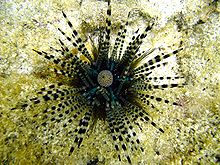Diadem sea urchin
| Diadem sea urchin | ||||||||||||
|---|---|---|---|---|---|---|---|---|---|---|---|---|

Diadem sea urchin ( Diadema setosum ) |
||||||||||||
| Systematics | ||||||||||||
|
||||||||||||
| Scientific name | ||||||||||||
| Diadematidae | ||||||||||||
| Gray , 1855 |
The Diadem sea urchins (Diadematidae) are a family of particularly long-pricked sea urchins (Echinoidea). They have very pointed, thin, hollow spines up to 30 centimeters long.
distribution
Diadem sea urchins live on the coasts of the tropical Indo-Pacific , the Red Sea and the tropical Atlantic . One species, the European diadem sea urchin ( Centrostephanus longispinus ) lives in the Mediterranean and the adjacent Atlantic.
Way of life
The animals prefer to stay in shallow water near rocks or coral reefs to a depth of about 30 meters. Some species also live in seagrass meadows or in the mangrove zone . During the day they hide in caves or crevices or huddle close together to protect them from predators, so that an impenetrable forest of thorns forms. The animals become active at night and graze on algae from hard substrates.
Predators
Despite their ability to defend themselves, diadem sea urchins are eaten by large trigger and puffer fish . The fish bite off the spines or try to turn the sea urchins around with a jet of water ejected with their mouth. Also Whelks as the Red cassinae and the king cassinae eat diadematidae whose calcareous shell and resolve them with sulfuric acid.
Numerous other animals also seek shelter between their spines, for example comb jellyfish of the genus Coeloplana , partner shrimp (Palaemoninae) and cardinalfish (Apogonidae).
Toxicity
Swimmers and divers can easily injure themselves on the spines of the diadem sea urchin. After the bite, you usually feel intense pain that lasts half an hour to four hours. No toxin has yet been isolated. Because of the victim's reaction, a potentially neurotoxic poison is suspected, likely contained in the thin skin that covers the spines. The brittle spines break off easily. Because of the rough surface and its fragility, it is difficult to remove from the wound.
Genera
-
Astropyga
- Magnificent diadem sea urchin ( Astropyga magnifica )
- Red diadem sea urchin ( Astropyga radiata ) (Leske, 1778)
-
Centrostephanus Peters, 1855
- Long-spiny diadem sea urchin ( Centrostephanus longispinus ) (Philippi, 1845)
- Chaetodiadema
-
Diadema J. E. Gray, 1825
- Atlantic diadem sea urchin ( Diadema antillarum ) (Philippi, 1845)
- East Pacific diadem sea urchin ( Diadema mexicanum )
- Savigny's diadem sea urchin ( Diadema savignyi ) (Michelin, 1845)
- Common diadem sea urchin ( Diadema setosum ) (Leske, 1778)
-
Echinothrix Peters, 1853
- Squid sea urchin ( Echinothrix calamaris ) (Pallas, 1774)
- Black diadem sea urchin ( Echinothrix diadema ) (Linnaeus, 1758)
- Lissodiadema
literature
- Jürgen Lange / Rainer Kaiser: Lower animals of tropical and cold seas , Verlag Eugen Ulmer, 1991, ISBN 3-8001-7222-4
- Harry Erhardt / Horst Moosleitner: Mergus Meerwasser Atlas , Volume 3, Mergus Verlag, 1997, ISBN 3-88244-103-8
- Svein A. Fossa / Alf Jacob Nilsen: Coral reef aquarium Volume 6 , Schmettkamp Verlag, 1998, ISBN 3-928819-18-6
Web links
Individual evidence
- ↑ Heinke Schultz, Shirtingen (2005): Interactions between mollusks and sea urchins (PDF; 3.7 MB) . Club Conchylia Information 37 (1/2) 41-48. P. 6: Cypraecassis rufa eats a diadem sea urchin Astropyga radiata .


